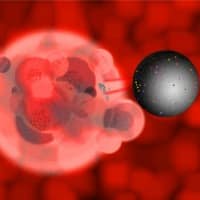Nanoengineers at the University of California/San Diego (UCSD; California, USA), have innovated “microfish” — fish-shaped microrobots tjat swim around efficiently in liquids, are chemically powered by hydrogen peroxide and magnetically controlled. Wei Zhu and colleagues combined D printing technology with microrobots, to custom-build microfish, then added functional nanoparticles into certain parts of the microfish bodies. They installed platinum nanoparticles in the tails, which react with hydrogen peroxide to propel the microfish forward, and magnetic iron oxide nanoparticles in the heads, which allowed them to be steered with magnets. The lead investigator observes that: “We have developed an entirely new method to engineer nature-inspired microscopic swimmers that have complex geometric structures and are smaller than the width of a human hair. With this method, we can easily integrate different functions inside these tiny robotic swimmers for a broad spectrum of applications.” The team is hopeful that their proof-of-concept synthetic microfish will inspire a new generation of “smart” microrobots that have diverse capabilities such as detoxification, sensing and directed drug delivery.
Go Fish
Wei Zhu, Jinxing Li, Yew J. Leong, Isaac Rozen, Xin Qu, Renfeng Dong, Zhiguang Wu, Wei Gao, Peter H. Chung, Joseph Wang, Shaochen Chen. “3D-Printed Artificial Microfish,” Advanced Materials, Volume 27, Issue 30, pages 4411–4417, August 12, 2015.
RELATED ARTICLES




